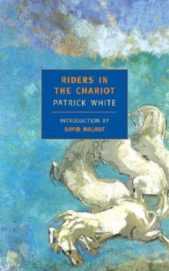 Patrick White
Patrick White
NYRB Classics ($24.95)
by Kiran Bhat
I have been stranded in Australia due to the lockdown regulations, and curious to re-assess my opinions on the country’s canonical literature, I found myself returning to the author Patrick White. I do not regret this decision. If you’re looking to get a taste of Australian literature, White is one voice above all that must be read; Henry Lawson comes close, Christina Stead even closer, but among White’s many novels, story collections, and plays are at least four books of literary importance, which puts him a cut above the rest. There’s a reason why he won the 1973 Nobel Prize in Literature, and why he remains so critically appreciated.
White’s novel Riders in the Chariot, available in the U.S. via the NYRB Classics series, offers a good example of his work. Riders in the Chariot details the lives of four very different Australians in an imaginary suburb of Sydney: a crazy heiress, a German Jewish refugee, a devout housewife, and an Aboriginal artist. All four are united because they have imagined a horse-drawn chariot. Each character interprets their vision differently, but the Biblical undertones of the vision are almost always in the background as the characters continue to live their lives.
Few writers combine mysticism and modernism as well as White. Of course, there is Faulkner, who wrote about the problems of the American South in a Biblical sort of register, and obviously Tagore, who came from a mystic literary background. What makes White different is landscape—he came from the rigid red soil of the Australian bush, and that is the territory he must unearth.
White also came from an Anglican background, and the combination of his inquiries into faith and the roots of his Australian culture combine beautifully in Riders in the Chariot. The book questions our perception of the infinite in a way that is neither dogmatic nor intrusive. The genuine curiosity White has towards the faithful recalls the great novels of Russian literature, but done in a hollow tone and desiccated language that only the Australian outback could have inspired.
